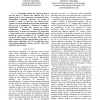Free Online Productivity Tools
i2Speak
i2Symbol
i2OCR
iTex2Img
iWeb2Print
iWeb2Shot
i2Type
iPdf2Split
iPdf2Merge
i2Bopomofo
i2Arabic
i2Style
i2Image
i2PDF
iLatex2Rtf
Sci2ools
CEC
2009
IEEE
2009
IEEE
Biocybernetic loop: From awareness to evolution
—Developing systems that support people in everyday life in a discrete and effective way is an ultimate goal of a new generation of technical systems. Physiological computing represents one means of creating a system to sense the user, analyse users’ responses to system adaptation and respond dynamically. This process of adaptation is achieved by creating a biocybernetic loop that may operate on several, simultaneous timescales (minutes/hours/weeks/ months/years). In terms of architecture, it is argued that a “sense-analyse-react” system requires middleware with closed-loop control consisting of: (1) a tangible layer concerned with sensors and actuators, (2) a reflective layer containing a flexible representation of the user to guide system adaptation, and (3) an application layer representing application scenarios and the context for adaptation and evolution.
Artificial Intelligence | CEC 2009 | Layer Representing Application | Simultaneous Timescales | Tangible Layer |
| Added | 20 May 2010 |
| Updated | 20 May 2010 |
| Type | Conference |
| Year | 2009 |
| Where | CEC |
| Authors | Nikola B. Serbedzija, Stephen H. Fairclough |
Comments (0)

